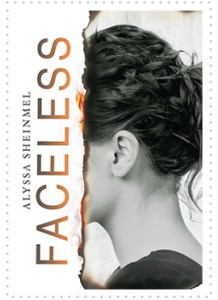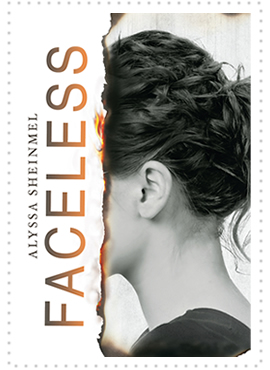For Maisie Winters, the protagonist in Alyssa Sheinmel’s novel Faceless, three syllables burdened with meaning are  those in ac·ci·dent. While Maisie is out running one rainy morning in late April, lighting strikes a tree, setting off a chain of events that end in hospitalization for this junior at Highlands High in San Francisco. Because “electrical fires burn hotter and faster than regular fires” (24), Maisie is now a girl without a face, but she doesn’t feel like the lucky miracle everyone keeps referring to her as. Even though she knows the question represents “a shallow and immature concern” (50), Maisie wonders whether she’ll ever be pretty again.
those in ac·ci·dent. While Maisie is out running one rainy morning in late April, lighting strikes a tree, setting off a chain of events that end in hospitalization for this junior at Highlands High in San Francisco. Because “electrical fires burn hotter and faster than regular fires” (24), Maisie is now a girl without a face, but she doesn’t feel like the lucky miracle everyone keeps referring to her as. Even though she knows the question represents “a shallow and immature concern” (50), Maisie wonders whether she’ll ever be pretty again.
When the opportunity for a transplant becomes available, Maisie considers her options: “remain faceless or take someone else’s face” (52). The idea that lists of donors or transplant waiting lists even existed had not previously occurred to Maisie, who was more familiar with shopping lists, homework lists, or to-do lists. Despite that a transplant means she’ll be on a drug regimen for the rest of her life and may never run again, she chooses to endure the operation that will make her better, not by taking things like charred muscle and bone away but by “putting things back” (60).
After the surgery, Maisie wears a “dead girl’s face” and feels like one of the gorgons from Greek mythology—ghoulish, hideous, and capable of inspiring fear. Because humans tend to be interested in things they don’t understand, Maisie is gawked at, pitied, and whispered about. Uncomfortable with all the adjustments she has to make, Maisie even finds friendship difficult and wonders whether she can ever again be the girl her boyfriend Chirag Srinivasan used to hug and kiss and hold. Wherever she goes, she feels vibes of sympathy, horror, sadness, and disgust.
With her new face also come new senses and sensations. For instance, she is no longer attracted to the scent of lilacs, her favorite flower, or to the taste of buttercream icing. She also suffers side-effects from the immunosuppressive drugs: nausea, fatigue, and headaches. Feeling deformed, deflated, and drugged into oblivion, Maisie doesn’t know how to live. She wants to feel romance butterflies in her belly, to dance at prom, to run, and to feel normal, pretty, and desired. Because a life without these is not a life worth living, Maisie contemplates ways to escape, to regain control, and to get her life back.
Desperate to help their daughter through her depression and despair, Sue and Graham Winters—whose favored form of communication is fighting—call a truce and force Maisie to choose life or death. Maisie decides she wants to live and claws her way back, inventing Maisie 2.0. But even Maisie 2.0 “sucks,” according to Maisie, who sees her life in terms of “Old Maisie: Competitive. Straight-A student. Runner. Morning person. Cool girlfriend” (211) and “New Maisie: Tired all the time. Bad girlfriend. . . . Grades slipping. Shy. Loser. . . . Afraid to drive. Ugly” (211).
With the help of her best friend Serena, Adam—who is just as damaged—, and a support group for people with transplants, Maisie moves through the five stages of grief and gradually learns to love herself again.
Sheinmel writes a poignant book that drags the reader through the psychological muck and mire of grief and loss, through the shifting and growing that define one’s identity. Maisie’s struggle provides a metaphor of sorts for the challenges and experiences that we all confront and tackle as we learn to accept the aspects of ourselves that we despise. With her novel, Sheinmel leads readers to the important conclusion: “You have to learn to love yourself before you can love someone else” (283).
- Posted by Donna

